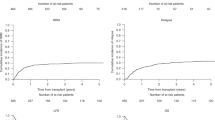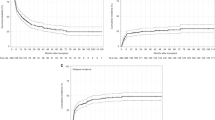Abstract
We have conducted a retrospective study on 251 patients from three centers in France and Switzerland between 2004 and 2010 with the goal to evaluate the impact of HLA-DRB3/B4/B5 allele mismatching after HLA-10/10-matched unrelated allogeneic hematopoietic stem cell transplantation (HSCT). Fourteen (5.5%) patients receiving HSCT from an HLA-10/10-matched unrelated donor had a mismatched DRB4 donor, 23 (9.5%) patients had a mismatched DRB3 donor and 214 (85%) had a fully matched unrelated donor (HLA-10/10) without DRB3- or DRB4-mismatched donor. We compared the outcomes of 37 patients with a DRB3 or DRB4 mismatch with the rest of the population. The median survival for a patient without DRB3/4 mismatch was 18 months (95% confidence interval (CI), 13–29), for DRB3-mismatched patients 32 months (95% CI, 13-NR) and for DRB4-mismatched patients 7 months (95% CI, 3-NR). The multivariate analysis showed a significant impact of DRB4 mismatching on survival (Hazards ratio (HR)=2.1 (95% CI, 1.01–4.67), P=0.045), acute GvHD (HR=2.66 (95% CI, 0.99–7.09) P=0.05) and on transplant-related mortality (HR=2.8; (95% CI, 1.7−4.4) P=0.024). In the view of an impact of DRB4 locus mismatch on clinical outcome, it would be important to confirm this observation in a prospective study as it may be worth considering DRB4 in the unrelated donor selection.
This is a preview of subscription content, access via your institution
Access options
Subscribe to this journal
Receive 12 print issues and online access
$259.00 per year
only $21.58 per issue
Buy this article
- Purchase on Springer Link
- Instant access to full article PDF
Prices may be subject to local taxes which are calculated during checkout


Similar content being viewed by others
References
Lee SJ, Klein J, Haagenson M, Baxter-Lowe LA, Confer DL, Eapen M et al. High-resolution donor–recipient HLA matching contributes to the success of unrelated donor marrow transplantation. Blood 2007; 110: 4576–4583.
Horan J, Wang T, Haagenson M, Spellman SR, Dehn J, Eapen M et al. Evaluation of HLA matching in unrelated hematopoietic stem cell transplantation for nonmalignant disorders. Blood 2012; 120: 2918–2924.
Petersdorf EW, Anasetti C, Martin PJ, Gooley T, Radich J, Malkki M et al. Limits of HLA mismatching in unrelated hematopoietic cell transplantation. Blood 2004; 104: 2976–2980.
Flomenberg N, Baxter-Lowe LA, Confer D, Fernandez-Vina M, Filipovich A, Horowitz M et al. Impact of HLA class I and class II high-resolution matching on outcomes of unrelated donor bone marrow transplantation: HLA-C mismatching is associated with a strong adverse effect on transplantation outcome. Blood 2004; 104: 1923–1930.
Woolfrey A, Klein JP, Haagenson M, Spellman S, Petersdorf E, Oudshoorn M et al. HLA-C antigen mismatch is associated with worse outcome in unrelated donor peripheral blood stem cell transplantation. Biol Blood Marrow Transplant 2011; 17: 885–892.
Morishima Y, Sasazuki T, Inoko H, Juji T, Akaza T, Yamamoto K et al. The clinical significance of human leukocyte antigen (HLA) allele compatibility in patients receiving a marrow transplant from serologically HLA-A, HLA-B, and HLA-DR matched unrelated donors. Blood 2002; 99: 4200–4206.
Bray RA, Hurley CK, Kamani NR, Woolfrey A, Muller C, Spellman S et al. National marrow donor program HLA matching guidelines for unrelated adult donor hematopoietic cell transplants. Biol Blood Marrow Transplant 2008; 14: 45–53.
Loiseau P, Busson M, Balere ML, Dormoy A, Bignon JD, Gagne K et al. HLA Association with hematopoietic stem cell transplantation outcome: the number of mismatches at HLA-A, -B, -C, -DRB1, or -DQB1 is strongly associated with overall survival. Biol Blood Marrow Transplant 2007; 13: 965–974.
Chalandon Y, Tiercy JM, Schanz U, Gungor T, Seger R, Halter J et al. Impact of high-resolution matching in allogeneic unrelated donor stem cell transplantation in Switzerland. Bone Marrow Transplant 2006; 37: 909–916.
Glucksberg H, Storb R, Ferfer A, Buckner CD, Neiman PE, Clift RA et al. Clinical manifestations of graft-versus-host disease in human recipients of marrow from HLA-matched sibling donors. Transplantation 1974; 18: 295–304.
Shulman HM, Sullivan KM, Weiden PL, McDonald GB, Striker GE, Sale GE et al. Chronic graft-versus-host disease syndrome in man. A long-term clinicopathologic study of 20 Seattle patients. Am J Med 1980; 69: 204–217.
Fine JP, Gray RJ . A proportional hazards model for the subdistribution of a competing risk. J Am Stat Assoc 1999; 94: 496–509.
Fernández-Viña M, Klein J, Spellman SR, Anasetti C, Noreen H, Baxter-Lowe LA et al. Multiple mismatches at the low expression HLA loci DP, DQ, and DRB3/4/5 associate with adverse outcomes in hematopoietic stem cell transplantation. Blood 2013; 121: 4603–4610.
Acknowledgements
We acknowledge the contribution of Elodie Morais, Sylvie Rey and all technicians of the different laboratories, the medical and nursing staff of the three centers.
Author information
Authors and Affiliations
Corresponding author
Ethics declarations
Competing interests
The authors declare no conflict of interest.
Rights and permissions
About this article
Cite this article
Detrait, M., Morisset, S., Chalandon, Y. et al. Suggestive evidence of a role of HLA-DRB4 mismatches in the outcome of allogeneic hematopoietic stem cell transplantation with HLA-10/10-matched unrelated donors: a French–Swiss retrospective study. Bone Marrow Transplant 50, 1316–1320 (2015). https://doi.org/10.1038/bmt.2015.157
Received:
Revised:
Accepted:
Published:
Issue Date:
DOI: https://doi.org/10.1038/bmt.2015.157
This article is cited by
-
Recurrent secondary graft failure likely due to a DRB4 donor-specific antibody in a patient with aplastic anemia and DRB4 null allele
Bone Marrow Transplantation (2021)
-
Deep sequencing of the MHC region in the Chinese population contributes to studies of complex disease
Nature Genetics (2016)



